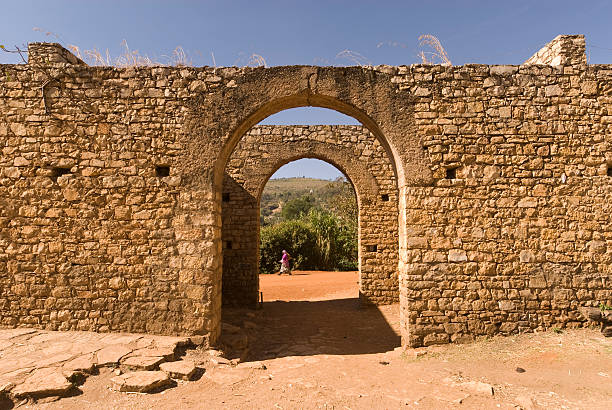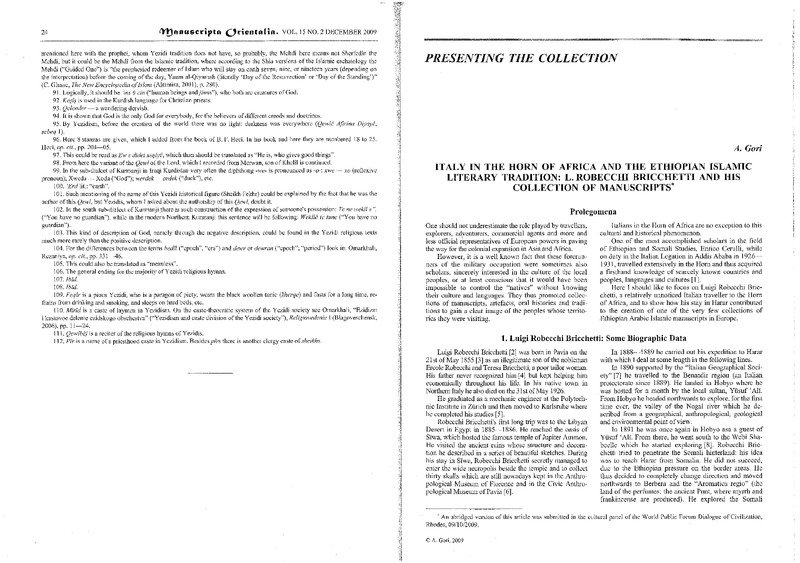Items
-
A leap of faithDate: 2003arly Muslims looked beseechingly to Ethiopia and sought refuge in its territory from their persecutors, the polytheist Arabians. But the Christian kingdom, besieged for 15 centuries by Islamic states that formed a formidable ring around it, refused to succumb to the new religion. Gamal Nkrumah explores the often contentious connection between Ethiopia and Islam -------------------------------------------------------------------------------- Since time immemorial Ethiopia has retained her supercilious air. Throughout the centuries, the rugged Nile Basin country, bound to Islam from the religion's inception, has attracted scant attention compared to Egypt. Ethiopia's seclusion, however, did nothing to dispel its mystique. Ethiopia's ambiguous identity fascinated those outsiders who cared to take a closer look. Black, but not black enough. Christian, but only partially so. At once both primitive and civilised. Numerous Arab and Muslim chroniclers have lavished praise on the only land beyond Arabia's borders that Prophet Mohamed turned to in his hour of need -- the only country that responded positively to his call for assistance. Perhaps the most important Arab treatise celebrating the special role Ethiopia played in early Islam was Jalal Al-Din Al-Suyuti's seminal work Raf^ Shan Al- Hubshan (The Raising of the Status of the Ethiopians), written in the late 15th century. It was an earnest plea to reaffirm the equality of the races in Islam. Ahmed Bin Ali Al-Maqrizi, who in 1435-36 wrote Kitab Al-Ilmam bi Akhbar man bi-Al- Habasha min Muluk Al-Islam (The Book of True Knowledge of the History of the Muslim Kings of Abyssinia), focussed on the mediaeval Muslim sultanates in the Horn of Africa, including those within the country today known as Ethiopia.
-
Aner2Date: 1990
-
Afocha: A Link between Community and Administration In Harar EthiopiaDate: 1978Rural Sociology; Winter81, Vol. 46 Issue 4, p754-756, 3p Document Type: Book Review Subject Terms: BOOKS -- ReviewsCOMMUNITY organizationNONFICTION<p
-
EthiopiaDate:
-
The Conquest of AbyssiniaDate:A translation of the Arabic book of Fathul Habash into English.Translated by Paul Lester StenhouseAnnotations with Richard PankhurstPreview not available.Availble to purchase from Malsay web site.
-
Italy in the Horn of Africa and the Ethiopian Islamic literary tradition: L. Robecchi Bricchetti and his collection of manuscriptsDate: 20091. Luigi Robecchi Bricchetti: some general biographical data Luigi Robecchi Bricchetti was born in Pavia on the 21st of May 1855 and in his native town in Northern Italy died on the 31st of May 1926. He was a graduated engineer of the Polytechnic Institute in Zurich.His first long trip was to the Libyan Desert in Egypt in 1885-86. He reached the oasis of Siwa, where the famous temple of Jupiter Ammon is located. He visited the ancient ruins whose structure and decoration he described in a series of beautiful sketches. During his stay in Siwa, Robecchi Bricchetti stealthily managed to entered the wide necropolis beside the temple and to collect thirty skulls which are still nowadays kept in the Anthropological Museum of Florence and in the Civic Anthropological Museum of Pavia.In 1888-1889 carried out his stay in Harar with which I deal at some length in the following lines.In 1890 supported by the “Italian Geographical Society & he travelled to the Benadir region (an Italian protectorate since 1889). He landed in Hobyo where he was hosted for a month by the local sultan, Yusuf Ali. From Hobyo he headed northwards to explore, for the first time ever, the valley of the Nogal river which he described from a geographical, anthropological, geological and environmental point of view.In 1891 he was once again in Hobyo by Yusuf ‘Ali. From there, he went south to the Webi Shabelle which he started exploring: however, the full exploration of the river valley was realized only later by Luigi Amedeo di Savoia Duca degli Abruzzi in 1928-9 (Enrico Cerulli took part in this expedition). Robecchi Bricchetti tried to penetrate the Somali hinterland: his idea was to reach Harar from Somalia. He did not succeed, due to the Ethiopian pressure on the Somali regions. He thus decided to completely change direction and moved northwards to Berbera and the “Aromatica regio” (the land of the perfumes: the ancient Punt, where myrrh and frankincense are produced). He explored the Somali coastal regions on the Gulf of Aden and came back to Italy. This was his last travel to the Horn.
-
Bibliographic Records of Ewald WagnerDate: 2009
-
To The Bosphore ÉgyptienDate: 1887On the road from Hérer, Dedjatch Mékonène, representing the King in Harar, has shipped from Harar to Shoa 3,000,000 rounds of ammunition, and other munitions that the English commissaries ordered to be abandoned for the profit of Emir Abdoullahi during the Egyptian evacuation. This whole road was impressively constructed for the first time by M. Jules Borelli on his recent trip to Harar in May 1886. It is geodesically connected to the topography and is parallel to the Itous Mountains.
-
The Manuscript Bindings of HararDate: 1987
-
Evolution of Smallholder Mixed Farming Systems in the Harar Highlands of Ethiopia: The Shift Towards Trees and ShrubsDate:The paper reports on the major changes observed in the farming systems of the Harar Highlands of southeastern Ethiopia, with special emphasis on the shift towards trees and shrubs. The study was undertaken during two time periods, 1985-1987 and 1997-1998 with the objectives of characterizing the production systems and their trends, and utilizing information so gained to guide research and extension activities in the study area. It was observed that the farming population had increased, land and large stock holding had decreased slightly, and that crop production was under increasing threats from various scourges, notably pests, weeds, and diseases. In the face of these changes, farmers continued to search for alternative strategies, and the major trend noted was the shift towards naturally growing and cultivated tree and shrub species in general and khat (Chata edulis (Vahl) Forsk. ex Endl.) in particular. This shift increased farm income and promoted crop-livestock integration, thereby improving household food security and enhancing sustainability of smallholder mixed farm systems. The importance of khat to the regional economy was also found to be growing both in the livelihood systems of the people in the study area, and in terms of foreign currency earnings. Despite the critics against the ever-increasing culture of khat, it is argued that the shift towards a khat-based farm economy was unavoidable, and, in the absence of other feasible alternatives, khat production and marketing would remain important to the livelihood systems of people in the study area. In view of this, the roles of the tree component in the farming systems should be duly considered in planning research and extension undertakings in the smallholder farms of the Harar Highlands of Ethiopia.
-
Insects of cultivated and wild plants,Date: 1966A serially numbered list is given of plant species, both cultivated and wild, with the insect species found associated with each in Harar Province, Ethiopia, during 1960 & 64. In a second list, the insect species are arranged under orders and, alphabetically, under families and genera, the plant species with which they were associated being indicated by numbers referring to the first list.
-
Harar and Lamu: A comparison of two East African muslim societiesDate: 1987Abstract Comparison of the social and political structure in two Muslim urban societies in East Africa - Harar in eastern Ethiopia and Lamu on the northern Kenyan coast - from the 18th to the early 20th century. In Lamu, as in other coastal Swahili societies, political authority was supposed to be vested with representatives of the leading families who claimed long-standing local residence and financial integrity. However, rulers were hardly ever able to develop absolute power; more often their rule was of the primus inter pares type. The political structure in Harar was hierarchical with a secular ruler, surrounded by a number of appointed officials, exercising absolute power. As in Lamu, social control within the Harari community appears to have been more democratic. Women in Lamu were considered socially, intellectually, and morally inferior. They were not supposed to have any part in public affairs. Despite the custom of infibulation and clitoridectomy, the status of women in Harar was far more independent; they had an equal share in the social and religious life of the city. (Source: ASC Documentation).
-
BOMBING OF HARAR USE OF POISON GAS WIDESPREAD INDIGNATIONDate: 1936The bombing of the people in Harar and Ethiopian army by Italian forces....
-
Entrance, in the foreground, to the ancient walled town of Harar (Abyssinia), which has been captureDate: 1941Entrance, in the foreground, to the ancient walled town of Harar (Abyssinia), which has been captured by British troops.
-
TROUBLE IN ABYSSINIADate: 19002000 MOSLEMS KILLED. LONDON, April 8. The Governor of Harar killed 2000 Moslems at Jigjiga, on the Abyssinian frontier. King Menelik sends him 8000 horsemen
-
An AttackDate: 1887AN ATTACK. Aden, January 24 News has been received from Somauli that the Abyssinian forces attacked and completely routed the Ameer of Harar's troops. They then occupied the town of Harar. The Ameer, however, escaped.
-
OBEISANCE’S TO ARTHURDate: 2010‘I left my life behind to catch a glimpse of life’ Arthur Rimbaud The road to Harar is green, along the way there are lush fields, terraced farms on slopes, high growing shrubs; the road winds upwards and it winds downwards. Children dance in its middle, they paint the white line that is not there, they own it, it is their road, they wave at the car as we weave around them. “Faranji, faranji,” they call, “you want, you want …, faranji, ten birr, ten birr …yooo, yooo yooo.” They wave branches of green leaves, they sell khat, the biggest cash crop that grows in the region, fresh, delirious. My excitement grows as we move up the slopes of the mountains, organic gold, I am going to the city of a poet, the city of an outcast who gave up poetry and turned to guns, the city of Rimbaud.
-
Abej 1of 1Date: 2008 E.C.Harar Gates, Mosques and Shrines are listed.Cultural Heritage is discussed in the Material too.
-
Z Herge Walagat 1 of 1Date: 1990Various Harari social concerns discussed and cultural practices revisited.
-
Z Herge Walagat 1 of 1Date: 1990Various Harari social concerns discussed and cultural practices revisited.


